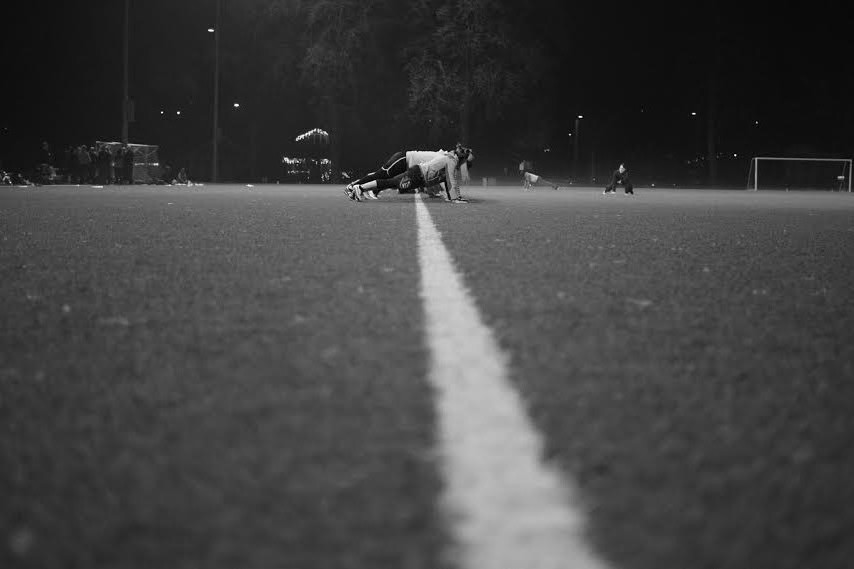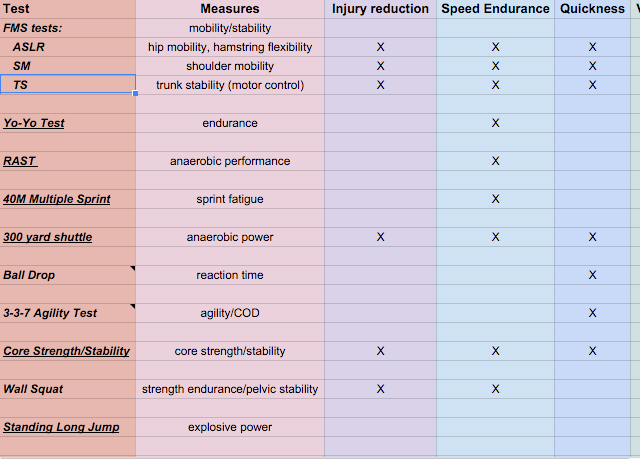 Photo by Ben Beehner
Photo by Ben Beehner
Each ultimate team has a unique culture, with different goals for the season, leadership structures, amount of practice time, and age range. Teams select the people they think will fit best with their system, some of whom are great athletes without much experience, some whom have the experience, but need to improve their athleticism. Benchmark tests allow leaders to assess the strengths and weaknesses of the individuals that make up a team. The idea is to perform these tests close to the beginning of the season, then repeat them in the middle and at the end. The goal is to measure improvement on some very specific axises: strength endurance, speed, quickness, etc.
Before we get into the tests that I recommend for ultimate, let’s take a moment to talk about the fact that this testing is pointless unless a team chooses the right tests and then actually does something with the knowledge gained. TL;DR – there is a nifty quick reference chart at the end of this article.
Where Does The Team Want To End Up?[footnote number=”1″]If the team is new, has had a lot of turnover, or if goals for the season have not been set, run a small battery of tests that cover all the bases –that will help define athletic strengths and build a strategy![/footnote]
That’s the first big question: what are the team’s goals for the season? Get better at shutdown defense? Improve throwing accuracy and completion rates? Win the party? Win Nationals? These goals require different athletic skills in addition to certain mentalities and practice structures. Understand what athletic skills go into fierce defense (not to mention the hip mobility required to win the party, DANG), then, as a team, start to test and work.
Where Is The Team Now?
This is the first round of benchmark testing. Choose the tests that provide information pertinent to team goals. This may seem self-explanatory, but oftentimes teams run a whole slew of benchmark tests, some of which are tough to administer and even harder to accurately measure, and some of which don’t have much to do with the team’s goals (or ultimate-specific movement). Just like in tryout testing, make sure the team is spending its time (and the athletes’ time) wisely! It’s actually less of a “Where are we now?” and more of a “Where are we now in relation to where we want to be?”
Getting From Here to There And Measuring Progress
This is the tricky part, and where a lot of teams could do more to set themselves up for success! First of all, make sure that the athletic aspects the team is asking athletes to strengthen are things that actually impact their game and help the team. Saying, “Your speed is a little below average, so we’re going to give you some homework to improve on that,” sounds like a good plan, but what if this year’s team really needs that person to be quicker instead of faster? Or what if they’re prone to injury? Or a handler? A plan to increase slightly deficient top speed won’t address those questions.
Secondly, make sure the team is able to find the resources it needs to actually improve these skills. Do the team captains or coaches know how to help people develop a quicker first step or cut more efficiently? If not, then it’s necessary to learn how, or bring in someone to teach these concepts –retesting in the middle of the season should give everyone a good indicator of whether or not they are are progressing.
On To The Tests
There are literally a billion. I chose some of the ones I think are most useful for ultimate. They cover a range of setups and judge a variety of athletic abilities. Refer to my previous article on testing to get a sense of how a test should be conducted to make sure the results are accurate –the same rules apply here. All these tests can be performed on a field. The only one that requires something not usually found there is the Wall Strength test which requires, you guessed it, a wall. Check these out for yourself and decide which ones will best suit your team!
What You Won’t Find In This Analysis
Strength tests that require a weight room (1 rep-max squats/deadlifts, pullups, bench press etc). These are great tests to do, and if the team has access to facilities to perform them and staff to record results or check form, go for it! Many teams don’t have that ability, though, so I’m sticking mostly to field tests.
Traditionally, benchmark tests have had to do mostly with strength and conditioning, but hopefully we know by now that how much players can lift and how fast 40-yard dash times are have a lot to do with the way the body works as a unit. So I’m including some Function Movement Screeing (FMS) tests that you can do as a group or individually, with no equipment.
Links For Descriptions And Videos Of The Tests
Click the snapshot below or use this link for the full battery of tests to explore, with links for each row for more resources:

If you have a specific team goal you’d like me to recommend some testing for, email me or comment below, I’m happy to help! Happy testing!
For extra credit: Here’s a version of the 3-hop test that doesn’t focus on distance traveled. It’s more of a training exercise and check-in than a benchmark test. It explains what is being tested and how in terms of progression.










Comments Policy: At Skyd, we value all legitimate contributions to the discussion of ultimate. However, please ensure your input is respectful. Hateful, slanderous, or disrespectful comments will be deleted. For grammatical, factual, and typographic errors, instead of leaving a comment, please e-mail our editors directly at editors [at] skydmagazine.com.